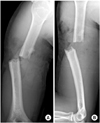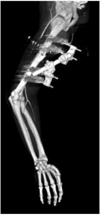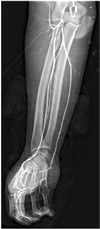Abstract
Although vascular injury after humeral fracture is very rare, it is a complication that has serious sequelae. It has been associated with proximal humeral fracture or shoulder dislocation in adults and humeral supracondylar fracture in children. However, delayed brachial artery occlusion after humeral shaft fracture has never been reported worldwide. Nevertheless, delayed brachial artery occlusion after humerus shaft fracture has the potential to cause serious complications in the short term as well as long term; therefore, it is essential to provide accurate diagnosis and prompt treatment. We report a case of delayed brachial artery occlusion after humeral shaft open fracture that was successfully treated with early diagnosis as well as effective treatment.
Figures and Tables
Fig. 1
Photograph shows 9 cm transverse open wound involving partial rupture of the muscles on the proximal 1/3 portion of the right arm.

Fig. 2
Initial anteroposterior (A) and lateral (B) plain radiographs show displaced transverse fracture of the humeral shaft.

Fig. 3
At 54 hours after injury, computed tomographic angiograph reveals occlusion of the right proximal brachial artery.

Fig. 4
Intraoperative angiogram after thrombectomy reveals revascularization of the radial artery, ulnar artery, and palmar arch arteries.

Fig. 5
(A) Closed reduction and intramedullary nailing was performed at 4 weeks after thrombectomy.
(B, C) For nonunion of the fracture site, additional locking plate fixation with autogenous iliac bone graft was performed at 5 months postoperatively.
(D) The fracture healed eventually without other complications.

References
1. Byrd RG, Byrd RP Jr, Roy TM. Axillary artery injuries after proximal fracture of the humerus. Am J Emerg Med. 1998. 16:154–156.

2. Crawford DL, Yuschak JV, McCombs PR. Pseudoaneurysm of the brachial artery from blunt trauma. J Trauma. 1997. 42:327–329.

3. Gallucci G, Ranalletta M, Gallucci J, De Carli P, Maignon G. Late onset of axillary artery thrombosis after a nondisplaced humeral neck fracture: a case report. J Shoulder Elbow Surg. 2007. 16:e7–e8.

4. Got C, Tan TW, Thakur N, Marcaccio EJ Jr, Eberson C, Madom I. Delayed presentation of a brachial artery pseudoaneurysm after a supracondylar humerus fracture in a 6-year-old boy: a case report. J Pediatr Orthop. 2010. 30:57–59.

5. Hayes JM, Van Winkle GN. Axillary artery injury with minimally displaced fracture of the neck of the humerus. J Trauma. 1983. 23:431–433.

6. Jensen BV, Jacobsen J, Andreasen H. Late appearance of arterial injury caused by fracture of the neck of the humerus. J Trauma. 1987. 27:1368–1369.

7. Kang CH, Cho CH, Sohn SW, Bae KC, Kim HT. Late-onset brachial artery icclusion caused by subclavian artery stenosis after clavicular fracture: a case report. J Korean Fract Soc. 2006. 19:494–496.

8. Linson MA. Axillary artery thrombosis after fracture of the humerus. A case report. J Bone Joint Surg Am. 1980. 62:1214–1215.

9. Met R, Bipat S, Legemate DA, Reekers JA, Koelemay MJ. Diagnostic performance of computed tomography angiography in peripheral arterial disease: a systematic review and meta-analysis. JAMA. 2009. 301:415–424.

10. Smyth EH. Major arterial injury in closed fracture of the neck of the humerus. Report of a case. J Bone Joint Surg Br. 1969. 51:508–510.




 PDF
PDF ePub
ePub Citation
Citation Print
Print


 XML Download
XML Download